LAND ROVER FRELANDER 2 2006 Repair Manual
Manufacturer: LAND ROVER, Model Year: 2006, Model line: FRELANDER 2, Model: LAND ROVER FRELANDER 2 2006Pages: 3229, PDF Size: 78.5 MB
Page 2771 of 3229
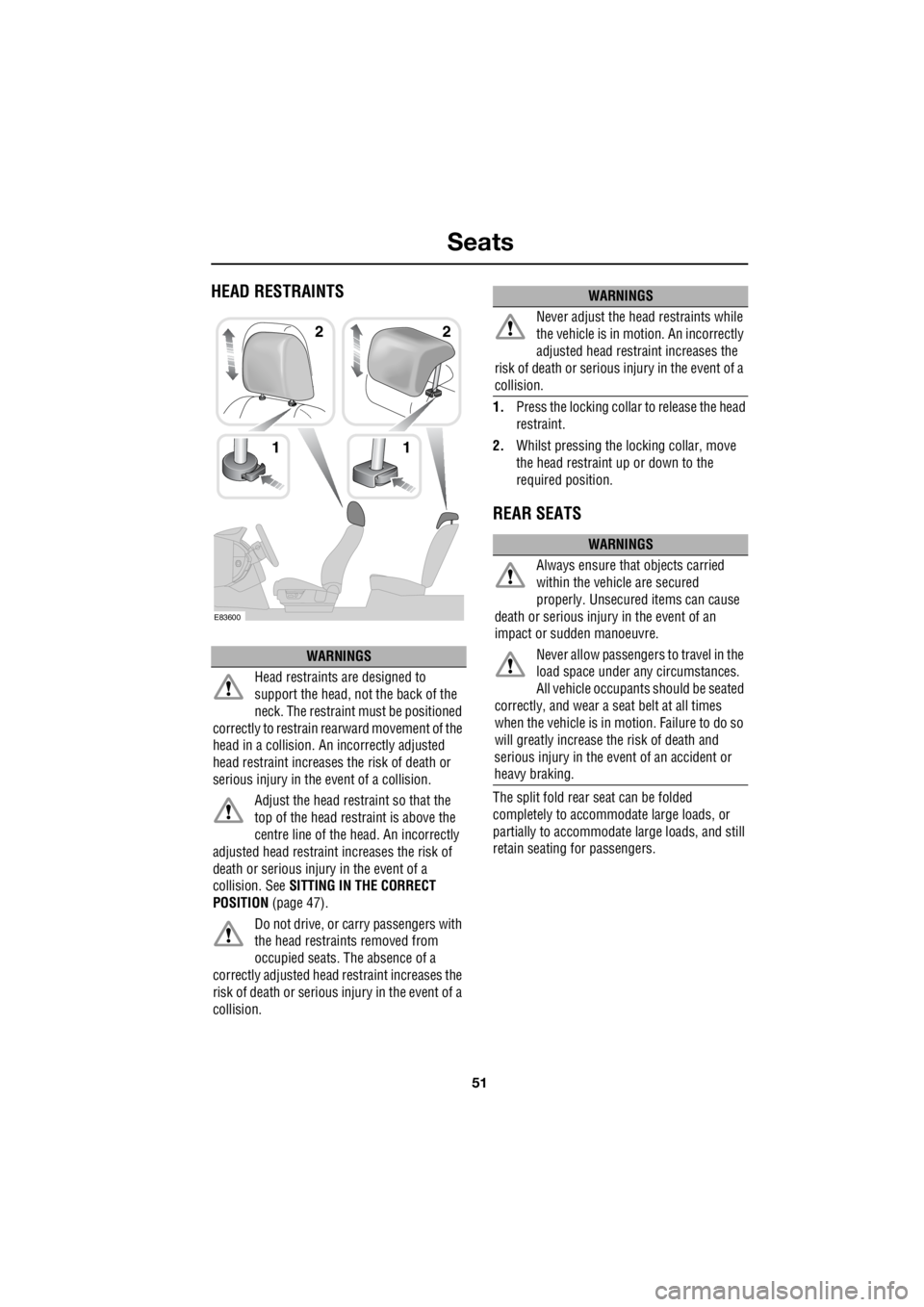
51
Seats
R
HEAD RESTRAINTS
1. Press the locking collar to release the head
restraint.
2. Whilst pressing the locking collar, move
the head restraint up or down to the
required position.
REAR SEATS
The split fold rear seat can be folded
completely to accommodate large loads, or
partially to accommodate large loads, and still
retain seating for passengers.
WARNINGS
Head restraints are designed to
support the head, not the back of the
neck. The restraint must be positioned
correctly to restrain re arward movement of the
head in a collision. An incorrectly adjusted
head restraint increases the risk of death or
serious injury in the event of a collision.
Adjust the head restraint so that the
top of the head restraint is above the
centre line of the he ad. An incorrectly
adjusted head restraint increases the risk of
death or serious injury in the event of a
collision. See SITTING IN THE CORRECT
POSITION (page 47).
Do not drive, or ca rry passengers with
the head restraints removed from
occupied seats. The absence of a
correctly adjusted head restraint increases the
risk of death or serious injury in the event of a
collision.
1
E83600
1
2 2Never adjust the head restraints while
the vehicle is in motion. An incorrectly
adjusted head restraint increases the
risk of death or serious injury in the event of a
collision.
WARNINGS
Always ensure that objects carried
within the vehicle are secured
properly. Unsecured items can cause
death or serious injury in the event of an
impact or sudden manoeuvre.
Never allow passengers to travel in the
load space under any circumstances.
All vehicle occupant s should be seated
correctly, and wear a seat belt at all times
when the vehicle is in motion. Failure to do so
will greatly increase the risk of death and
serious injury in the event of an accident or
heavy braking.
WARNINGS
Page 2772 of 3229
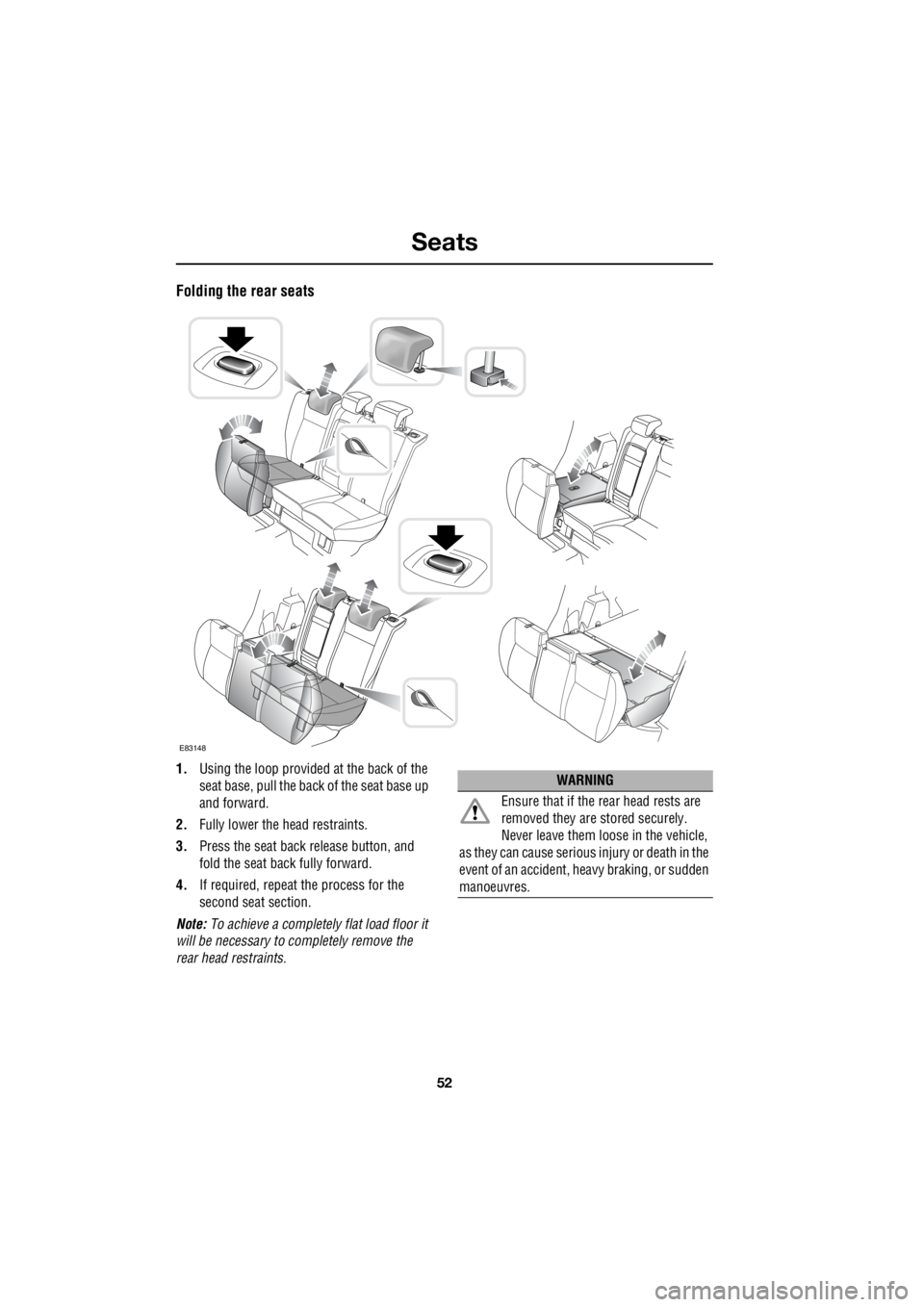
Seats
52
L
Folding the rear seats
1. Using the loop provided at the back of the
seat base, pull the back of the seat base up
and forward.
2. Fully lower the head restraints.
3. Press the seat back release button, and
fold the seat back fully forward.
4. If required, repeat the process for the
second seat section.
Note: To achieve a completely flat load floor it
will be necessary to co mpletely remove the
rear head restraints.
E83148
WARNING
Ensure that if the rear head rests are
removed they are stored securely.
Never leave them loose in the vehicle,
as they can cause serious injury or death in the
event of an accident, he avy braking, or sudden
manoeuvres.
Page 2773 of 3229
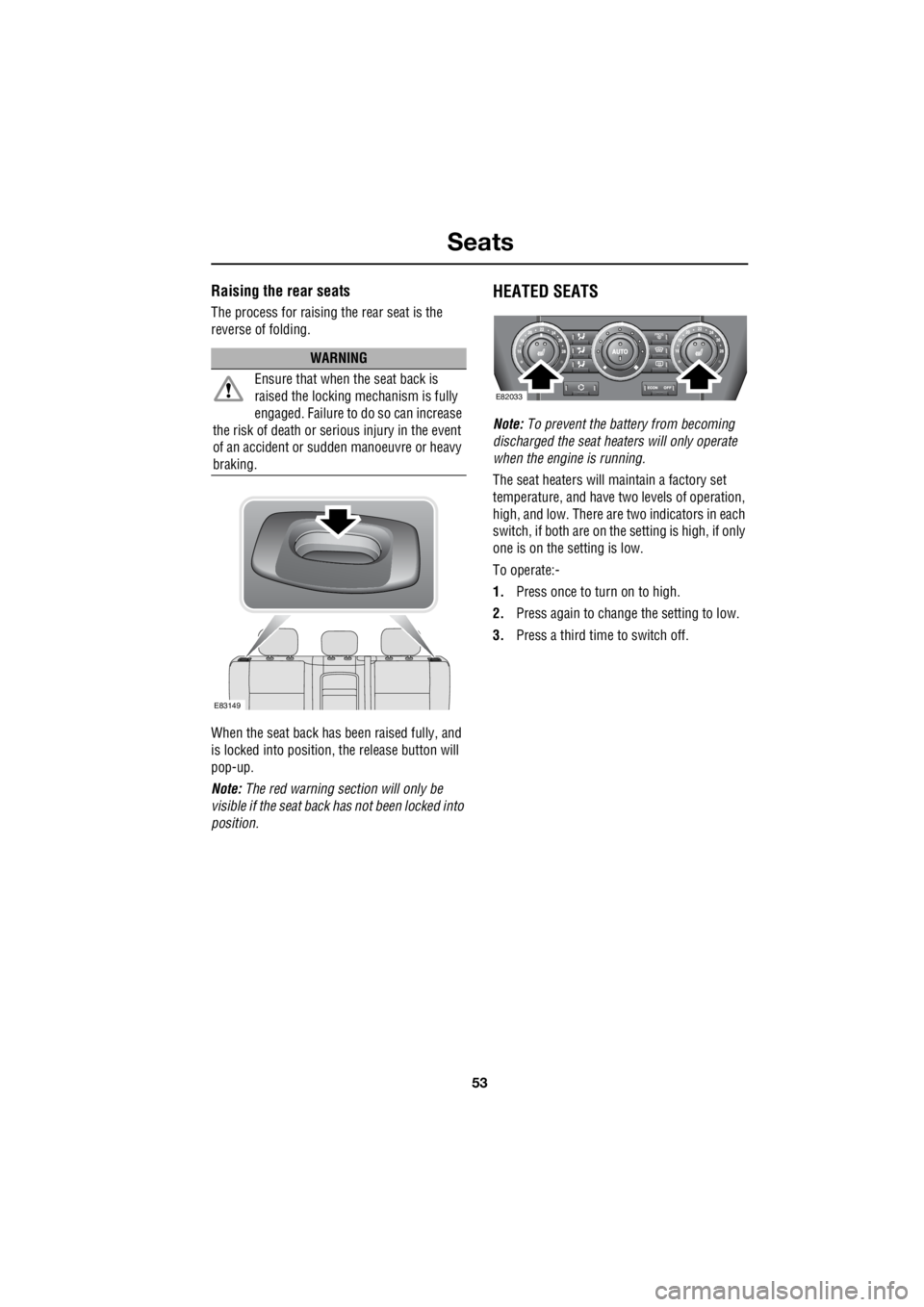
53
Seats
R
Raising the rear seats
The process for raising the rear seat is the
reverse of folding.
When the seat back has been raised fully, and
is locked into position, the release button will
pop-up.
Note: The red warning section will only be
visible if the seat back has not been locked into
position.
HEATED SEATS
Note: To prevent the battery from becoming
discharged the seat heaters will only operate
when the engine is running.
The seat heaters will maintain a factory set
temperature, and have two levels of operation,
high, and low. There are two indicators in each
switch, if both are on the setting is high, if only
one is on the setting is low.
To operate:-
1. Press once to turn on to high.
2. Press again to change the setting to low.
3. Press a third time to switch off.
WARNING
Ensure that when the seat back is
raised the locking mechanism is fully
engaged. Failure to do so can increase
the risk of death or serious injury in the event
of an accident or s udden manoeuvre or heavy
braking.
E83149
E82033
Page 2774 of 3229
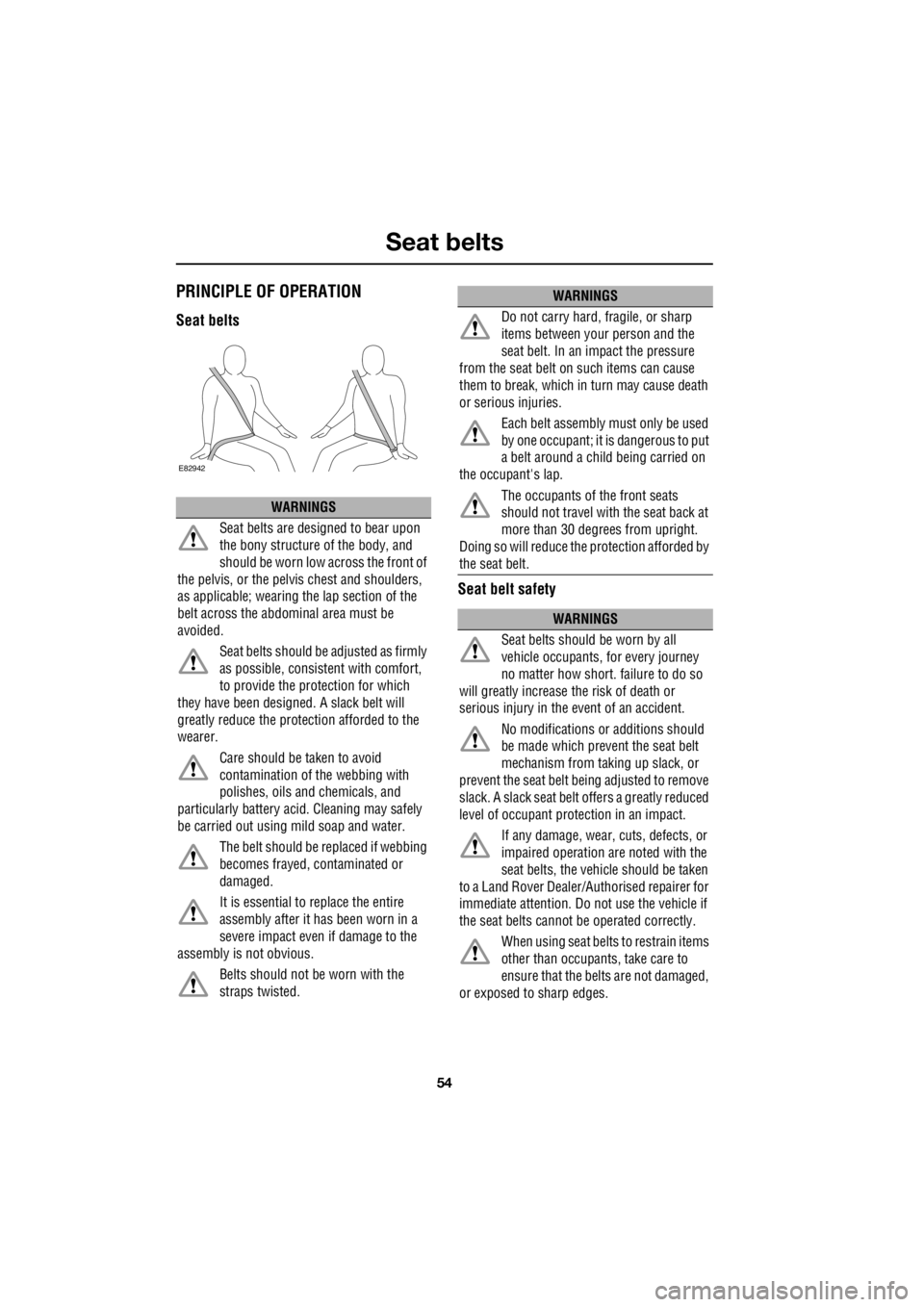
Seat belts
54
L
Seat beltsPRINCIPLE OF OPERATION
Seat belts Seat belt safety
WARNINGS
Seat belts are designed to bear upon
the bony structure of the body, and
should be worn low across the front of
the pelvis, or the pelv is chest and shoulders,
as applicable; wearing the lap section of the
belt across the abdominal area must be
avoided.
Seat belts should be adjusted as firmly
as possible, consistent with comfort,
to provide the protection for which
they have been design ed. A slack belt will
greatly reduce the protec tion afforded to the
wearer.
Care should be taken to avoid
contamination of the webbing with
polishes, oils and chemicals, and
particularly battery acid . Cleaning may safely
be carried out using mild soap and water.
The belt should be replaced if webbing
becomes frayed, contaminated or
damaged.
It is essential to replace the entire
assembly after it has been worn in a
severe impact even if damage to the
assembly is not obvious.
Belts should not be worn with the
straps twisted.
E82942
Do not carry hard, fragile, or sharp
items between your person and the
seat belt. In an impact the pressure
from the seat belt on such items can cause
them to break, which in turn may cause death
or serious injuries.
Each belt assembly must only be used
by one occupant; it is dangerous to put
a belt around a child being carried on
the occupant's lap.
The occupants of the front seats
should not travel with the seat back at
more than 30 degrees from upright.
Doing so will reduce the protection afforded by
the seat belt.
WARNINGS
Seat belts should be worn by all
vehicle occupants, for every journey
no matter how short. failure to do so
will greatly increase the risk of death or
serious injury in the event of an accident.
No modifications or additions should
be made which prevent the seat belt
mechanism from taking up slack, or
prevent the seat belt being adjusted to remove
slack. A slack seat belt offers a greatly reduced
level of occupant prot ection in an impact.
If any damage, wear, cuts, defects, or
impaired operation are noted with the
seat belts, the vehicle should be taken
to a Land Rover Dealer/Authorised repairer for
immediate attention. Do not use the vehicle if
the seat belts cannot be operated correctly.
When using seat belts to restrain items
other than occupants, take care to
ensure that the belts are not damaged,
or exposed to sharp edges.
WARNINGS
Page 2775 of 3229

55
Seat belts
R
Seat belt checks
Note: If the vehicle is parked on an incline, the
seat belt mechanism may lock. This is not a
fault, and the belt shoul d be gently eased out
from the upper anchorage.
The seat belts should be inspected regularly to
check for fraying, cuts, or wear to the webbing,
and the condition and security of the
mechanism, buckles, adjusters, and mounting
points.
Checks
• With the seat belt fastened, give the
webbing near the buckle a quick upward
pull. The buckle must remain securely
locked.
• With the seat belt unfastened, unreel the
seat belt to the limit of its travel. Check that
it unreels smoothly with no snatches or
snags. Allow the belt to fully retract, again
checking for smooth operation.
• Partially unreel the seat belt, then hold the
tongue plate and give a quick forward pull.
The mechanism must lock and prevent any
further unreeling.
If any of the seat belts fail to meet those
criteria, immediately contact you Land Rover
Dealer/Authorised Repairer.
SEAT BELT REMINDER
If the driver's se at belt is not
fastened when the vehicle is in
motion, a chime will be heard and
the seat belt warning i ndicator will illuminate.
The warning chime and indicator will also be
activated if the front passenger seat is
occupied without the seat belt being fastened.
Note: Objects placed on the front passenger
seat may activate the seat belt reminder
warning chime and indicator. It is
recommended that any objects placed on the
front passenger seat are secured using the seat
belt.
Care must be
taken to avoid
contaminating the seat belt webbing,
and seat belt mechanisms with any
chemicals, liquids, gr it, dirt, or cleaning
products. If the seat belts do become
contaminated they should be replaced
immediately. Contaminated seat belts my not
operate correctly in an impact and cannot be
relied upon.
WARNINGS
Page 2776 of 3229
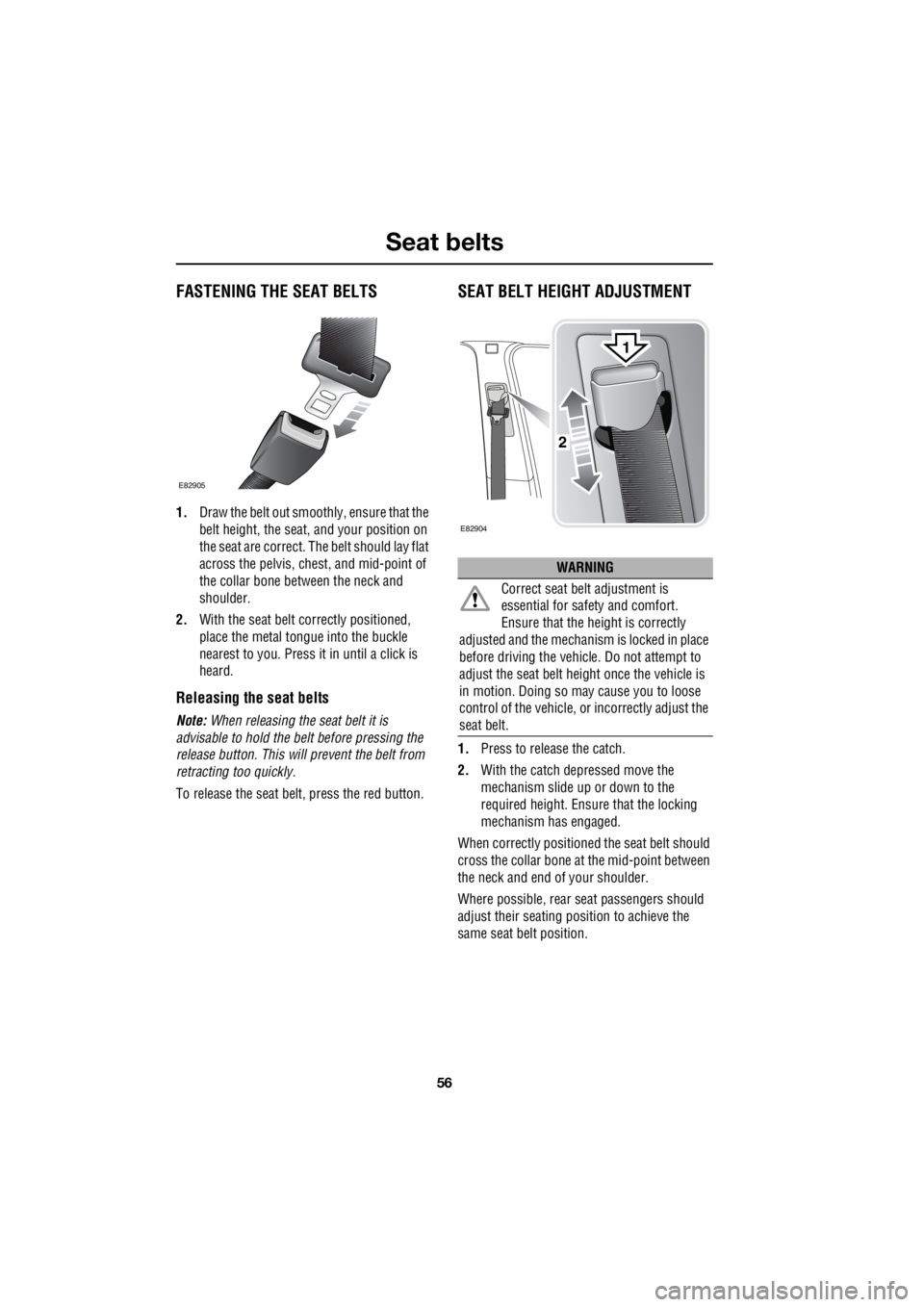
Seat belts
56
L
FASTENING THE SEAT BELTS
1. Draw the belt out smoothly, ensure that the
belt height, the seat, and your position on
the seat are correct. The belt should lay flat
across the pelvis, chest, and mid-point of
the collar bone between the neck and
shoulder.
2. With the seat belt correctly positioned,
place the metal tongue into the buckle
nearest to you. Press it in until a click is
heard.
Releasing the seat belts
Note: When releasing the seat belt it is
advisable to hold the belt before pressing the
release button. This will prevent the belt from
retracting too quickly.
To release the seat be lt, press the red button.
SEAT BELT HEIGHT ADJUSTMENT
1.Press to release the catch.
2. With the catch depressed move the
mechanism slide up or down to the
required height. Ensure that the locking
mechanism has engaged.
When correctly positione d the seat belt should
cross the collar bone at the mid-point between
the neck and end of your shoulder.
Where possible, rear se at passengers should
adjust their seating position to achieve the
same seat belt position.
E82905
WARNING
Correct seat belt adjustment is
essential for safe ty and comfort.
Ensure that the hei ght is correctly
adjusted and the mechanism is locked in place
before driving the vehicl e. Do not attempt to
adjust the seat belt height once the vehicle is
in motion. Doing so ma y cause you to loose
control of the vehicle, or incorrectly adjust the
seat belt.
E82904
2
1
Page 2777 of 3229
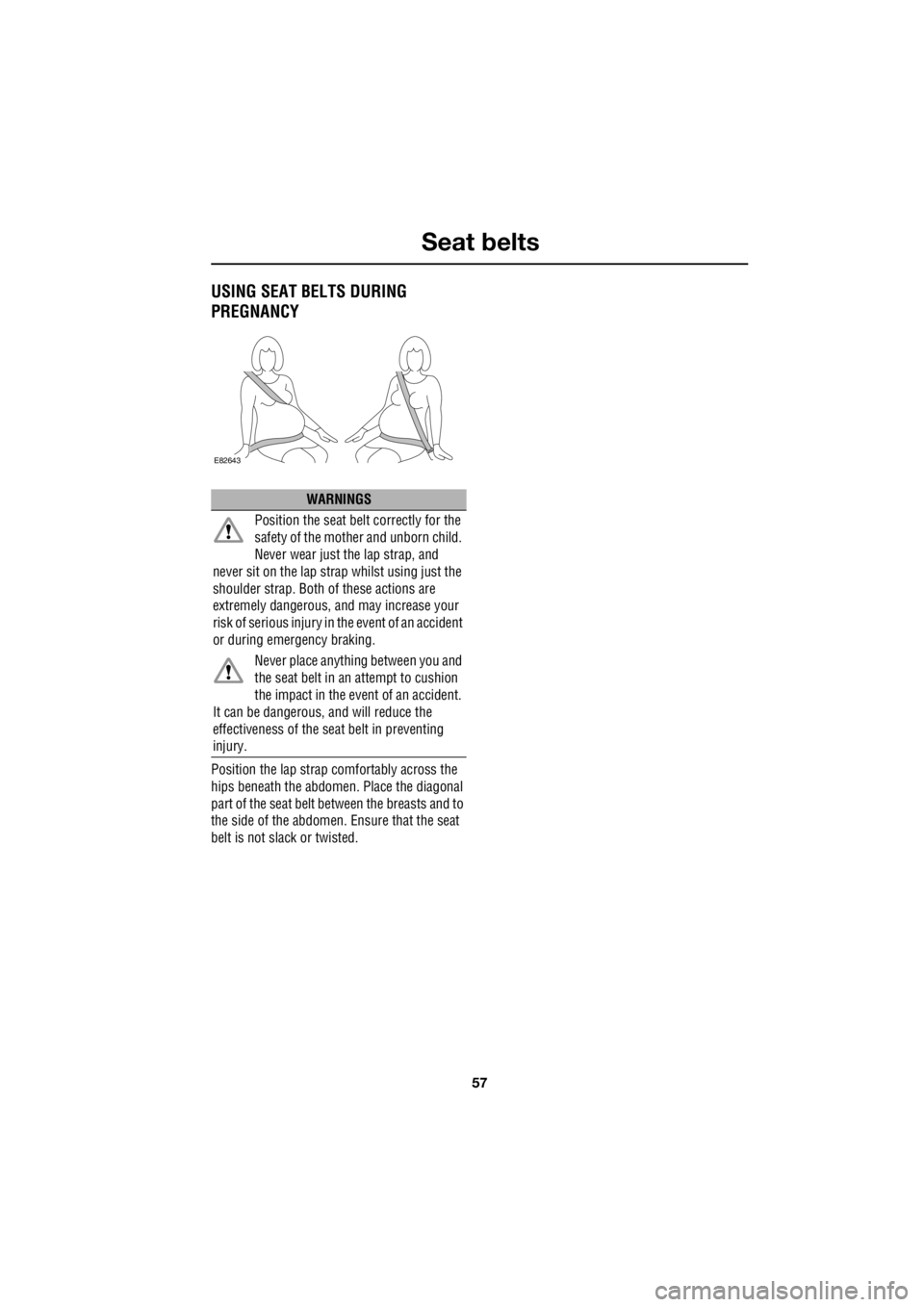
57
Seat belts
R
USING SEAT BELTS DURING
PREGNANCY
Position the lap strap co mfortably across the
hips beneath the abdomen. Place the diagonal
part of the seat belt be tween the breasts and to
the side of the abdomen. Ensure that the seat
belt is not slack or twisted.
WARNINGS
Position the seat belt correctly for the
safety of the mother and unborn child.
Never wear just the lap strap, and
never sit on the lap strap whilst using just the
shoulder strap. Both of these actions are
extremely dangerous, and may increase your
risk of serious injury in the event of an accident
or during emergency braking.
Never place anything between you and
the seat belt in an attempt to cushion
the impact in the event of an accident.
It can be dangerous, and will reduce the
effectiveness of the seat belt in preventing
injury.
E82643
Page 2778 of 3229

Supplementary restraints system
58
L
Supplementary restraints systemPRINCIPLE OF OPERATION
Introduction
In the event of a collision the airbag control unit
monitors the rate of de celeration caused by the
collision. This information is then used to
determine whether airbags should be
deployed.
Airbag deployment is de pendent on the rate at
which the passenger compartment changes
speed following the collision. The
circumstances affecting different collisions
(vehicle speed, angle of impact, type and size
of object hit, etc) vary considerably, and will
affect the rate of de celeration accordingly.
The Supplementary Restraint System (SRS)
components include :-
• SRS warning indicator.
• Rotary coupler.
• Airbag modules.
• Seat belt pr e-tensioners.
• Airbag diagnostic control unit.
• Crash sensors.
• Airbag wiring harnesses.
• Seat occupancy sensor.
Note: The SRS is not designe d to operate as a
result of:
• Rear impacts.
• Minor front impacts.
• Minor side impacts.
• Heavy braking.
• Driving over bumps and pot holes.
Therefore, it follows that considerable
superficial damage to the vehicle can occur
without causing the airbags to deploy.
Page 2779 of 3229
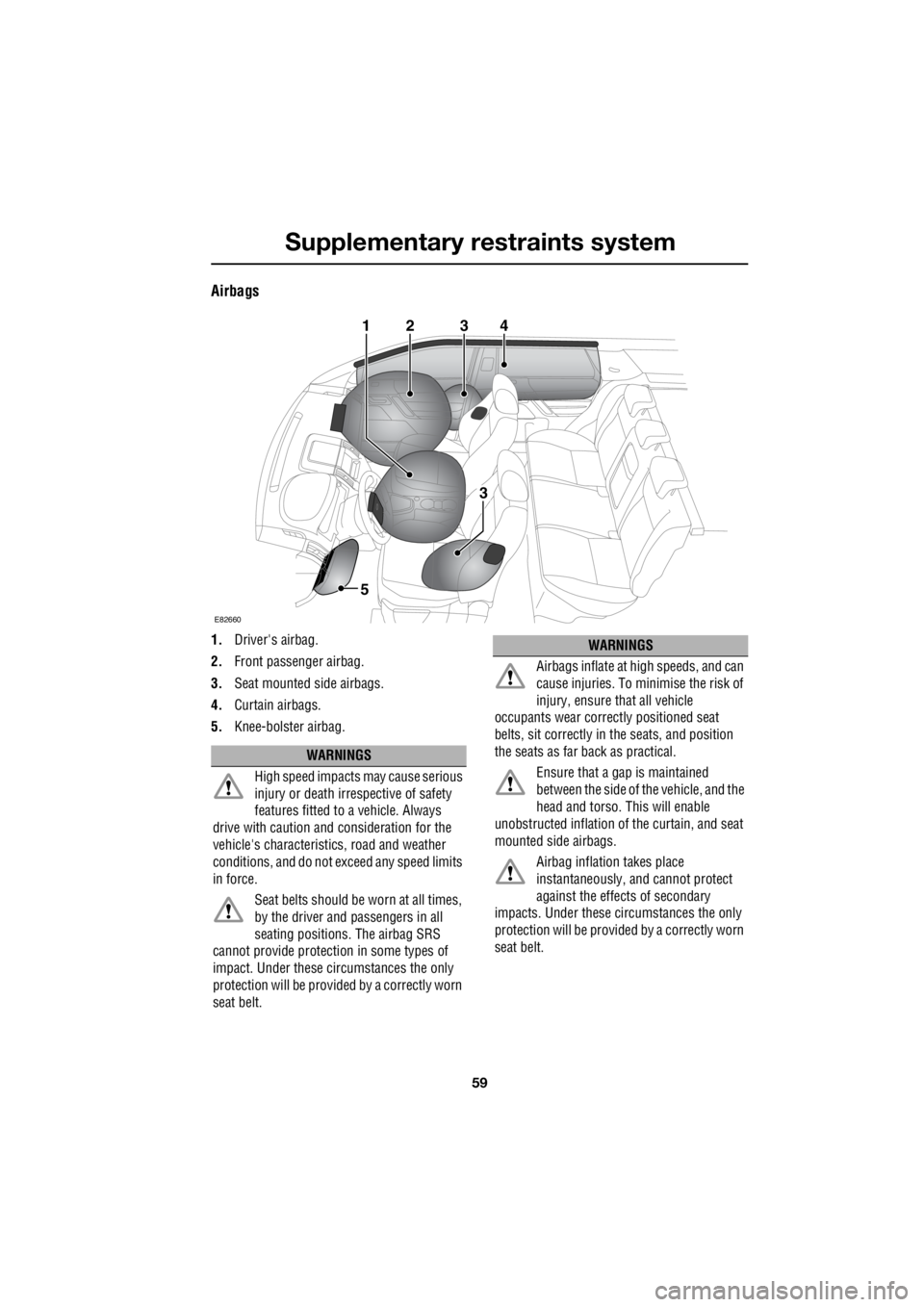
59
Supplementary restraints system
R
Airbags
1. Driver's airbag.
2. Front passenger airbag.
3. Seat mounted side airbags.
4. Curtain airbags.
5. Knee-bolster airbag.
E82660
34
3
5
21
WARNINGS
High speed impacts may cause serious
injury or death irre spective of safety
features fitted to a vehicle. Always
drive with caution and consideration for the
vehicle's characteristics, road and weather
conditions, and do not exceed any speed limits
in force.
Seat belts should be worn at all times,
by the driver and passengers in all
seating positions. The airbag SRS
cannot provide protection in some types of
impact. Under these circumstances the only
protection will be provided by a correctly worn
seat belt.
Airbags inflate at high speeds, and can
cause injuries. To minimise the risk of
injury, ensure that all vehicle
occupants wear correct ly positioned seat
belts, sit correctly in the seats, and position
the seats as far back as practical.
Ensure that a gap is maintained
between the side of the vehicle, and the
head and torso. This will enable
unobstructed inflation of the curtain, and seat
mounted side airbags.
Airbag inflation takes place
instantaneously, a nd cannot protect
against the effects of secondary
impacts. Under these circumstances the only
protection will be provided by a correctly worn
seat belt.
WARNINGS
Page 2780 of 3229

Supplementary restraints system
60
L
Note: The location points of airbags fitted to
the vehicle are marked by the word AIRBAG
embossed into the trim.
Always contact your Land Rover
Dealer/Authorised repairer if :-
• An airbag inflates.
• The front or sides of the vehicle are
damaged.
• Any part of the SRS shows signs of
cracking or damage, including trim
covering airbags.
Airbag operation
Airbags cannot deploy co rrectly if they are
obstructed. Examples of obstructions are :-
• Any part of an occupa nts body in contact
with, or close to, an airbag cover. •
Objects placed on, or close to, an airbag
cover.
• Clothing, sun screens, or other material
hanging from grab handles.
• Clothing, cushions, or other material,
covering seat mounted airbags.
• Seat covers which are not approved by
Land Rover, or specifically designed for
use with seat mounted airbags.
This list is not exhaustive, and it remains the
responsibility of the driv er and passengers to
ensure that the airbags are not obstructed in
any way.
Deployment and deflation
In the event of a collision the airbag control
system monitors the ra te, and direction of
deceleration. If required to supplement the seat
belts, airbags will be deployed as appropriate.
Front airbags
The front passenger's, and driver's airbags are
able to deploy in two stages depending on the
severity of the frontal impact. In a severe
impact the airbags inflate fully to offer
maximum protection. In a lesser impact full
deployment is not require d, so the airbags are
partially inflated.
Side and curtain airbags
Side and curtain airbag s are designed to offer
increased protection for the torso and head in
a side impact. The curtain airbags deflate at a
slower rate than the front, or side airbags to
afford greater protection from serious head
injuries.
Phone systems should only be
installed by qualified persons familiar
with the operation of, and
requirements for, vehicles fitted with SRS. If
you are in any doubt, seek advice from your
Land Rover Dealer/Authorised repairer.
WARNINGS
For the airbags to operate correctly the
roof lining and door post trims must
be in good condition, correctly fitted,
and free from obstructi on. Any damage, wear,
or incorrect fitment shoul d be referred to your
Land Rover Dealer/Aut horised repairer as
soon as possible for ex amination and repair.
Do not allow passe ngers to obstruct
the operation of the airbags by placing
any part of their person, or any
objects, in contact with, or close to, an airbag
module. Airbags deploy at very high speeds,
and can cause serious inju ry or death if objects
or occupants are within the area of
deployment.
WARNINGS